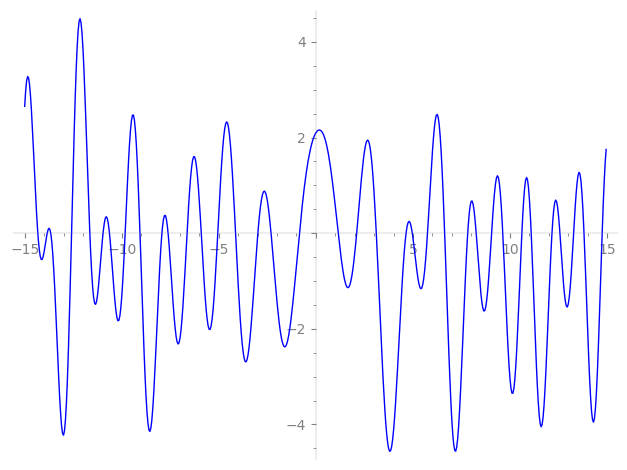| L(s) = 1 | + (1.22 + 2.12i)5-s + (2 − 1.73i)7-s + (−3.67 − 2.12i)11-s + (1.5 + 0.866i)13-s + (−2.44 − 4.24i)17-s + (4.5 + 2.59i)19-s + (−0.499 + 0.866i)25-s + (7.34 − 4.24i)29-s − 1.73i·31-s + (6.12 + 2.12i)35-s + (2.5 − 4.33i)37-s + (6.12 − 10.6i)41-s + (5.5 + 9.52i)43-s − 2.44·47-s + (1.00 − 6.92i)49-s + ⋯ |
| L(s) = 1 | + (0.547 + 0.948i)5-s + (0.755 − 0.654i)7-s + (−1.10 − 0.639i)11-s + (0.416 + 0.240i)13-s + (−0.594 − 1.02i)17-s + (1.03 + 0.596i)19-s + (−0.0999 + 0.173i)25-s + (1.36 − 0.787i)29-s − 0.311i·31-s + (1.03 + 0.358i)35-s + (0.410 − 0.711i)37-s + (0.956 − 1.65i)41-s + (0.838 + 1.45i)43-s − 0.357·47-s + (0.142 − 0.989i)49-s + ⋯ |
\[\begin{aligned}\Lambda(s)=\mathstrut & 2268 ^{s/2} \, \Gamma_{\C}(s) \, L(s)\cr =\mathstrut & (0.959 + 0.281i)\, \overline{\Lambda}(2-s) \end{aligned}\]
\[\begin{aligned}\Lambda(s)=\mathstrut & 2268 ^{s/2} \, \Gamma_{\C}(s+1/2) \, L(s)\cr =\mathstrut & (0.959 + 0.281i)\, \overline{\Lambda}(1-s) \end{aligned}\]
Particular Values
| \(L(1)\) |
\(\approx\) |
\(2.100444681\) |
| \(L(\frac12)\) |
\(\approx\) |
\(2.100444681\) |
| \(L(\frac{3}{2})\) |
|
not available |
| \(L(1)\) |
|
not available |
\(L(s) = \displaystyle \prod_{p} F_p(p^{-s})^{-1} \)
| $p$ | $F_p(T)$ |
|---|
| bad | 2 | \( 1 \) |
| 3 | \( 1 \) |
| 7 | \( 1 + (-2 + 1.73i)T \) |
| good | 5 | \( 1 + (-1.22 - 2.12i)T + (-2.5 + 4.33i)T^{2} \) |
| 11 | \( 1 + (3.67 + 2.12i)T + (5.5 + 9.52i)T^{2} \) |
| 13 | \( 1 + (-1.5 - 0.866i)T + (6.5 + 11.2i)T^{2} \) |
| 17 | \( 1 + (2.44 + 4.24i)T + (-8.5 + 14.7i)T^{2} \) |
| 19 | \( 1 + (-4.5 - 2.59i)T + (9.5 + 16.4i)T^{2} \) |
| 23 | \( 1 + (11.5 - 19.9i)T^{2} \) |
| 29 | \( 1 + (-7.34 + 4.24i)T + (14.5 - 25.1i)T^{2} \) |
| 31 | \( 1 + 1.73iT - 31T^{2} \) |
| 37 | \( 1 + (-2.5 + 4.33i)T + (-18.5 - 32.0i)T^{2} \) |
| 41 | \( 1 + (-6.12 + 10.6i)T + (-20.5 - 35.5i)T^{2} \) |
| 43 | \( 1 + (-5.5 - 9.52i)T + (-21.5 + 37.2i)T^{2} \) |
| 47 | \( 1 + 2.44T + 47T^{2} \) |
| 53 | \( 1 + (7.34 - 4.24i)T + (26.5 - 45.8i)T^{2} \) |
| 59 | \( 1 + 4.89T + 59T^{2} \) |
| 61 | \( 1 - 3.46iT - 61T^{2} \) |
| 67 | \( 1 + 7T + 67T^{2} \) |
| 71 | \( 1 - 12.7iT - 71T^{2} \) |
| 73 | \( 1 + (-13.5 + 7.79i)T + (36.5 - 63.2i)T^{2} \) |
| 79 | \( 1 - 11T + 79T^{2} \) |
| 83 | \( 1 + (-6.12 - 10.6i)T + (-41.5 + 71.8i)T^{2} \) |
| 89 | \( 1 + (-7.34 + 12.7i)T + (-44.5 - 77.0i)T^{2} \) |
| 97 | \( 1 + (3 - 1.73i)T + (48.5 - 84.0i)T^{2} \) |
| show more | |
| show less | |
\(L(s) = \displaystyle\prod_p \ \prod_{j=1}^{2} (1 - \alpha_{j,p}\, p^{-s})^{-1}\)
Imaginary part of the first few zeros on the critical line
−9.061313032686154086623642414351, −7.931299324237971938256311437029, −7.61331086483192036448938207410, −6.63661709158694244730586355380, −5.90487058051588486006938662534, −5.05505020731523204652697960674, −4.13781527531344861937415804981, −2.98967228899574325155870663363, −2.30975967598393781598465575746, −0.846706754561214188095659513614,
1.15031662543625120323626117614, 2.10026909795911422861601332131, 3.11066504735015657509267173023, 4.64410579613311872015319241701, 4.96519519972310333616036248701, 5.74854335452822610088829726668, 6.63168760727701289525982868948, 7.81947817410969487325615276383, 8.256154196176301498436214814242, 9.050776894131879730368992415373

